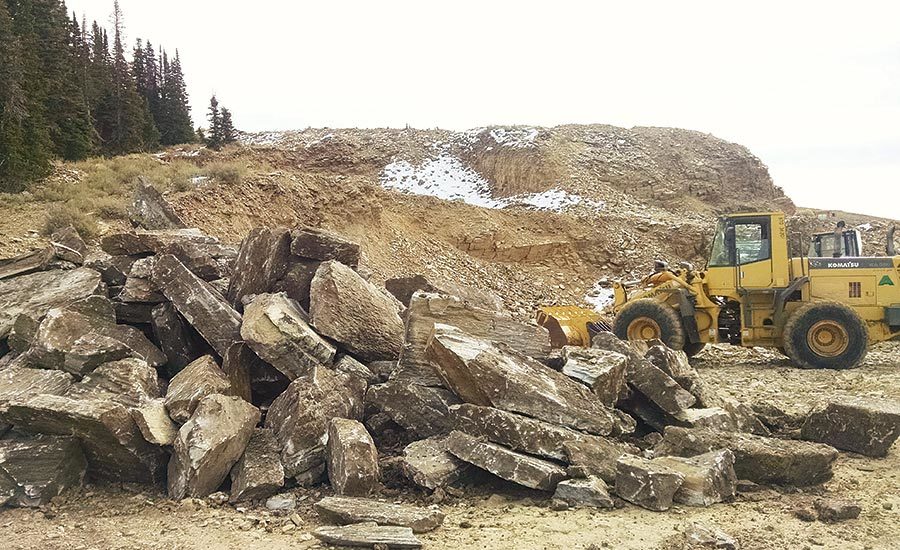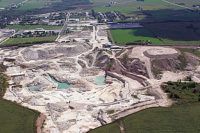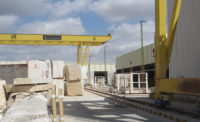Walter Thomas has had a lot of jobs throughout his life, but the one his son Lon loved the best was quarrying. A retreat to the mountains to quarry with the family was like a vacation — the only one an Idaho farm boy like himself had ever known. Lon Thomas loved being able to run into the woods with only the sound of his mother’s whistle — one blast meant yell your location, two meant return to camp — to keep him and his four siblings in line. He did his best to help his dad, though he now jokes that the small rocks he was able to lift were likely not too helpful.
Fast-forward a few years and 14-year-old Thomas wanted to get a job, but no one would hire him because of his age and small stature. So he and his younger brother, Evan, chose to quarry the site their father had originally staked out in Idaho. Calling themselves Star Stone Quarries, the two brothers sold the resulting quartzite to a stone retailer in Utah. When the stone retailer passed away less than five years later, Walter, Lon and Evan purchased the business, expanding their quarry operation to include a distribution yard.
At its height, the company would span the U.S. and lay claim to being a national leader in national cleft flagstone production, but the beginning was not nearly so grand. Walter, Lon and Evan had to work long days and nights in all sorts of weather and with all sorts of broken equipment. The stories are mind boggling.
In one such story, Lon Thomas recalls a truck with a rusted tank. He said, “You could never get more than 10 miles, might be 15 if it was downhill, before you had to stop it and blow the rust out of the fuel filter so you could keep going. [It was] louder than heck, just blaring loud, [and it] had no insulation between the motor and the cab. There was just metal. On the passenger side, the floor when you were driving at night would be red hot. We put rocks on the floor so it didn’t melt [our] shoes.”
This sort of problem solving became the norm for Star Stone Quarries, and mechanically minded Thomas also began to do his own engineering — designing everything from diamond-bladed saws to roadways.
One notable invention that can be attributed to Thomas is the process of rock tumbling — originally, a cement mixer he used like a clothes dryer to soften the edges of rock.
The road to today also had its disasters. Well before the economic downturn that shook the entire stone industry to its foundation, Evan Thomas was killed in a quarrying accident. Less than a year later, Walter Thomas was nearly paralyzed when the Mack truck he was driving was hit by a train.
The accidents devastated Lon Thomas and his wife, Beverley, and left them running the business by themselves. They had just given birth to the first of their six children.
It’s no wonder the couple now has a sign reading “We can do hard things” hanging in their home. If there’s one thing Thomas learned on the farm while he was young, it was that he could do anything if he just worked hard enough.
That work ethic not only kept Star Stone Quarries running, but also helped it flourish. Beverley Thomas kept the books — though she did shock people when they saw her also driving forklifts and loading customers — and Lon Thomas minded the quarries; both did sales. They hired great employees, some of whom, decades later, are still with the company. With that work ethic and a lot of perseverance, they made it through.
Expanding its capabilities
Today, Star Stone Quarries has active quarries in Idaho, Utah, Arizona and Nevada, and it is in expansion mode, recently opening a new saw shop and staging yard in Oakley, ID, this fall.
The new Oakley yard will service two quarries in the area — one being Walter Thomas’ original quarry — and house bridge saws, corner saws, thin veneer saws, guillotines, a rock crusher and various other pieces of processing equipment. These will mainly be used to cut quartzite, but Star Stone Quarries also has a granite deposit the saw shop will service.
Rock being channeled into and out of the location includes Autumn Gold, a gray and gold quartzite; Buckskin, a brown, gold and gray quartzite; Storm Mountain, a silver quartzite with golden veins; Fish Creek Brown, a gray quartzite with a brown finish; Windridge, a dark brown, weathered quartzite with various accent colors; and Mountain Ash granite, a gray granite with bronze streaks.
The Oakley crew is focused on cutting thin veneer and custom orders; the waste will be crushed into decorative gravel. The location will also store patio stone, selects, boulders, rubble and guillotined rock.
This location will nearly double Star Stone Quarries’ production capacity, and the company expects to ship tens of thousands of tons of rock out of Oakley each year. The first trucks started arriving to pick up stone before construction was even completely finished.
While Thomas has many employees now, he turned to two of his best to help build this new location, his sons Dan and Tyler Thomas.
The three men spearheaded construction of the Oakley yard throughout the summer, with Tyler helping to engineer the building and some of its equipment, and Lon and Dan taking point on the actual construction.
The problem solving that characterizes Star Stone Quarries manifested itself when the builders hit a high water table resulting from a particularly wet winter. According to Tyler Thomas, “We would dig down 3 feet and have a standing pool. [So] Lon dug a massive hole to the side of the building, a ways off, to try to lower the water table where the building was.”
The extra hole, which measured several yards in diameter, did the trick. It soon filled with water, allowing the construction to continue.
The vacation feeling from the old days was back in the air after work that day when the three men — once again, a father and two of his sons — jumped into the makeshift pool to cool off and play in the water.
|
Stone being cut at the Star Stone Quarries Oakley Yard: Autumn Gold: A gold and gray quartzite |













